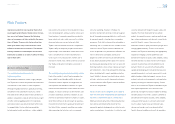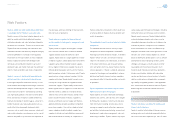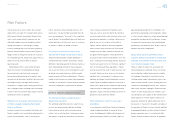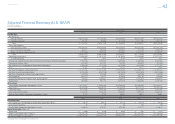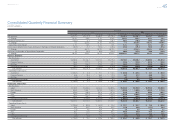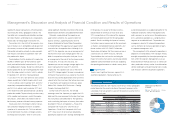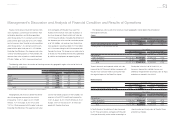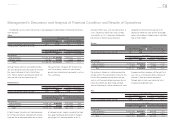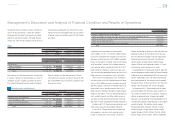Toyota 2013 Annual Report Download - page 49
Download and view the complete annual report
Please find page 49 of the 2013 Toyota annual report below. You can navigate through the pages in the report by either clicking on the pages listed below, or by using the keyword search tool below to find specific information within the annual report.
Toyota Global Vision President’s Message Launching a New Structure Special Feature Review of Operations
Consolidated Performance
Highlights
Management and
Corporate Information Investor InformationFinancial Section
Page 49
NextPrev
ContentsSearchPrint
ANNUAL REPORT 2013
signifi cantly impact comparisons with prior periods
and among the various geographic markets, the
translation risk is a reporting consideration and does
not refl ect Toyota’s underlying results of operations.
Toyota does not hedge against translation risk.
Transaction risk is the risk that the currency struc-
ture of Toyota’s costs and liabilities will deviate from
the currency structure of sales proceeds and assets.
Transaction risk relates primarily to sales proceeds
from Toyota’s non-domestic operations from vehi-
cles produced in Japan.
Toyota believes that the location of its production
facilities in different parts of the world has signifi -
cantly reduced the level of transaction risk. As part
of its globalization strategy, Toyota has continued to
localize production by constructing production facili-
ties in the major markets in which it sells its vehicles.
In calendar 2011 and 2012, Toyota produced
71.3% and 75.4% of its non-domestic sales outside
Japan, respectively. In North America, 66.8% and
75.3% of vehicles sold in calendar 2011 and 2012
respectively were produced locally. In Europe, 57.7%
and 58.5% of vehicles sold in calendar 2011 and
2012 respectively were produced locally. Localizing
production enables Toyota to locally purchase many
of the supplies and resources used in the produc-
tion process, which allows for a better match of
local currency revenues with local currency expenses.
Toyota also enters into foreign currency transac-
tions and other hedging instruments to address
a portion of its transaction risk. This has reduced,
but not eliminated, the effects of foreign currency
exchange rate fl uctuations, which in some years
in the previous fi scal year to the local currency-
denominated net revenues for fi scal 2012 and
2013, respectively, as if the value of the Japanese
yen had remained constant for the comparable
periods. Results excluding the impact of currency
fl uctuations year-on-year are not on the same basis
as Toyota’s consolidated fi nancial statements and
do not conform with U.S. GAAP. Furthermore,
Toyota does not believe that these measures are a
substitute for U.S. GAAP measures. However,
Toyota believes that such results excluding the
impact of currency fl uctuations year-on-year provide
additional useful information to investors regarding
the operating performance on a local currency basis.
Segmentation
Toyota’s most signifi cant business segment is its
automotive operations. Toyota carries out its
can be signifi
cant. See notes 20 and 26 to the consoli-
dated fi nancial statements for additional information.
Generally, a weakening of the Japanese yen
against other currencies has a positive effect on
Toyota’s revenues, operating income and net
income attributable to Toyota Motor Corporation.
A strengthening of the Japanese yen against other
currencies has the opposite effect. Although, in fi s-
cal 2012, the Japanese yen was on average and at
the end of the fi scal year stronger against the U.S.
dollar in comparison to the prior fi scal year, it was
on average and at the end of the fi scal year weaker
in fi scal 2013. In fi scal 2012 and 2013, the
Japanese yen was on average stronger against the
euro in comparison to fi scal 2011 and 2012,
respectively. The Japanese yen was at the end of
fi scal 2012 stronger against the euro in comparison
to the prior fi scal year, but was weaker at the end of
fi scal 2013 due to the depreciation of the yen in the
second half of the fi scal year. See further discussion
in “Quantitative and Qualitative Disclosures about
Market Risk—Market Risk Disclosures—Foreign
Currency Exchange Rate Risk”.
During fi scal 2012 and 2013, the average
exchange rate of the Japanese yen against the U.S.
dollar and the euro compared to the prior fi scal year
has fl uctuated as described above. The operating
results excluding the impact of currency fl uctuations
described in “Results of Operations—Fiscal 2013
Compared with Fiscal 2012” and “Results of
Operations—Fiscal 2012 Compared with Fiscal
2011” show results of net revenues obtained by
applying the Japanese yen’s average exchange rate
automotive operations as a global competitor in the
worldwide automotive market. Management allo-
cates resources to, and assesses the performance
of, its automotive operations as a single business
segment on a worldwide basis. Toyota does not
manage any subset of its automotive operations,
such as domestic or overseas operations or parts,
as separate management units.
The management of the automotive operations is
aligned on a functional basis with managers having
oversight responsibility for the major operating func-
tions within the segment. Management assesses
fi nancial and non-fi nancial data such as vehicle unit
sales, production volume, market share information,
vehicle model plans and plant location costs to allo-
cate resources within the automotive operations.
The following table sets forth Toyota’s net revenues in each geographic
market based on the country location of the parent company or the
subsidiaries that transacted the sale with the external customer for the
past three fi scal years.
Yen in millions
Years Ended March 31,
2011 2012 2013
Japan ¥6,966,929 ¥7,293,804 ¥7,910,456
North America 5,327,809 4,644,348 6,167,821
Europe 1,920,416 1,917,408 2,003,113
Asia 3,138,112 3,116,849 4,058,629
Other* 1,640,422 1,611,244 1,924,173
* “Other” consists of Central and South America, Oceania and Africa.
Geographic Breakdown
Management’s Discussion and Analysis of Financial Condition and Results of Operations
왎 Japan 왎 North America 왎 Europe
왎 Asia 왎 All Other Markets
Revenues by Market
FY2013
35.8%
28.0%
9.1%
18.4%
8.7%
Selected Financial Summary (U.S. GAAP) Consolidated Segment Information Consolidated Quarterly Financial Summary Management’s Discussion and Analysis of Financial Condition and Results of Operations [4 of 26] Consolidated Financial Statements Notes to Consolidated Financial Statements
Management’s Annual Report on Internal Control over Financial Reporting Report of Independent Registered Public Accounting Firm


